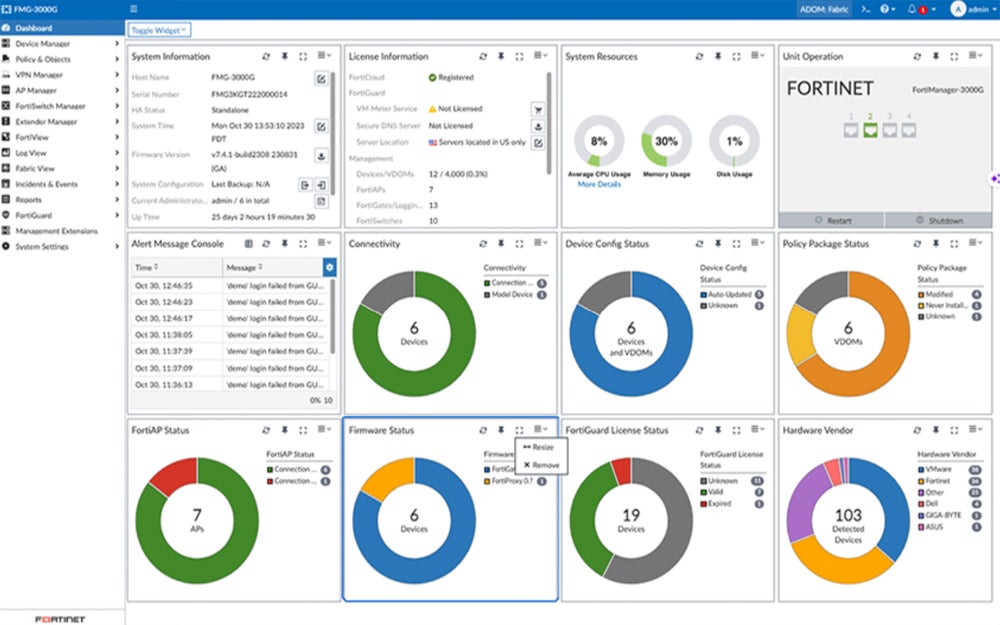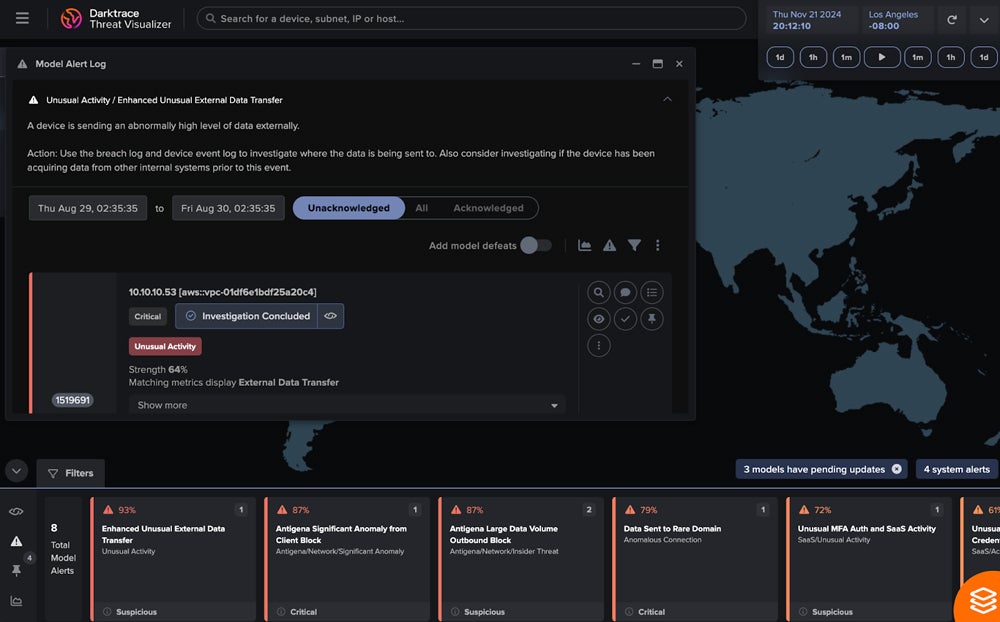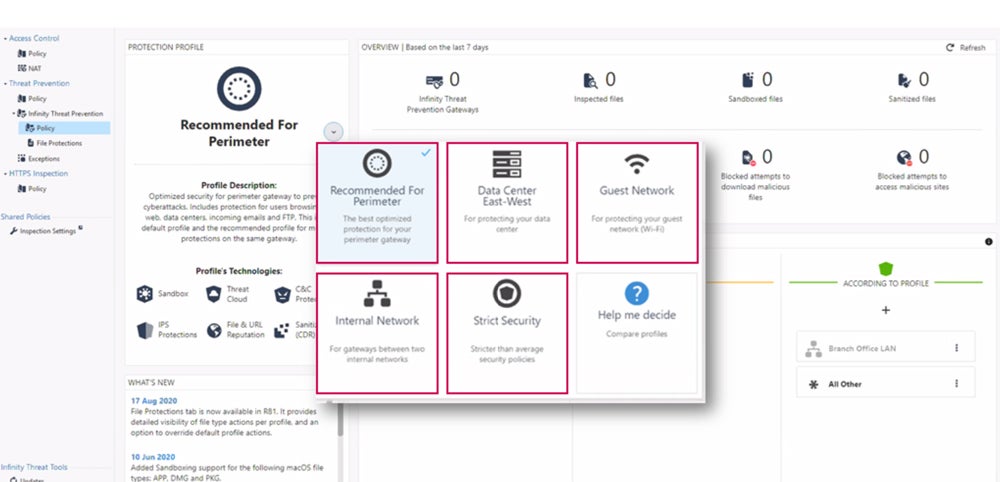Network security service providers are managed service providers that offer organizations solutions to defend themselves against cyberthreats and ensure the safety and integrity of their networks. The top network security providers stand out for capabilities like firewall protection, intrusion protection, data loss prevention, VPNs, and email security. To help you choose the most suitable provider for your use case, we’ve carefully assessed and highlighted six providers.
Here are the six best network security service providers for 2024:
- Palo Alto Networks: Best overall for cost and offerings (30-day free trial)
- Fortinet: Best for a blend of intuitiveness and support (free demo)
- Darktrace: Best for AI automation capabilities (free demo)
- Cisco: Best option for robust network security approach (free demo)
- Check Point: Best provider for integration possibilities (free demo)
- CrowdStrike: Best for advanced threat intelligence (15-day free trial)
- Sophos: Best for comprehensive endpoint protection (free demo)
Top network security service providers comparison
Before choosing a service provider for your network security, you need to know the services that the top providers offer. These providers cover a wide range of services across the network attack surface. Below, we’ve compared the service providers across the top five services to expect from network security service providers.
| Firewall | Email security | DLP | Vulnerability management | Intrusion prevention systems | |
|---|---|---|---|---|---|
| Palo Alto Networks | ✔ | ✔ | ✔ | ✔ | ✔ |
| Fortinet | ✔ | ✔ | ✔ | ✔ | ✔ |
| Darktrace | — | ✔ | ✔ | ✔ | ✔ |
| Cisco | ✔ | — | — | ✔ | ✔ |
| Check Point | ✔ | ✔ | ✔ | ✔ | ✔ |
| CrowdStrike | — | — | — | — | — |
| Sophos | — | ✔ | ✔ | — | — |
While each provider has unique strengths, we found Palo Alto Networks to offer the best overall value in balancing cost with offerings. Keep reading to understand how each provider performed in terms of pricing, offerings, and primary use cases, or jump down to see our evaluation process to determine the best options for network security.

Palo Alto Networks
Best overall for cost and offerings
Overall rating: 4.3/5
- Core offerings: 4.8/5
- Cost: 4/5
- Customer support: 3.2/5
- Ease of use: 4.4/5
- Security approach: 4.7/5
- Integration capabilities: 4.5/5
Palo Alto Networks is our pick for the best overall network security service provider as it offers a massive catalog of advanced features through Strata, its network security platform, to take on the latest AI-driven threats. Some of these capabilities include cloud-delivered security services, next-generation firewalls, and secure access service edge, among others. Capabilities aside, even though its pricing information isn’t public, Palo Alto offers a variety of pricing options and offers free trials and a virtual test drive.
Though it excels in offering an impressive suite of features and cost-effective solutions, there’s room for improvement in customer support. Should you place a high emphasis on customer support and want a solution with a huge roster of effective features, consider Fortinet.
| Pros | Cons |
|---|---|
| Advanced threat prevention | Opaque pricing |
| Extensive network protection | Steeper learning curve |
| AI/ML-driven analysis | Customization can be complex |
Pricing
- Contact for quote: Firewall, network threat protection, IoT, and data security modules
- Free trial: 30 days
Key offerings
- Prevention-focused architecture: Ensure a proactive approach to network security, minimizing vulnerabilities for your teams and clients.
- Automated security: Reduce manual effort and allow your teams to focus on critical security tasks.
- Advanced threat prevention: Offer your users thorough protection against a wide array of network threats.
- Security operating platform: Leverage a unified platform to manage security across your networks comprehensively.


Fortinet
Best for a blend of intuitiveness and support
Overall rating: 4.2/5
- Core offerings: 4.7/5
- Cost: 3.5/5
- Customer support: 4.8/5
- Ease of use: 4.6/5
- Security approach: 4.4/5
- Integration capabilities: 2.9/5
Fortinet’s FortiGate is a network security service provider that offers an intuitive interface and exceptional support, giving users the best of both worlds in terms of ease of use without compromising on security capabilities. Its FortiCare Technical Support is a per-device support service that has over 1,800 experts to serve Fortinet users round the clock, via three tiers for enterprise customers, Essential, Premium, and Elite. Elite offers 15-minute response times for major Fortinet product families.
While Fortinet is easy to use and has great support, its integration capabilities have room for improvement. For those seeking more extensive integration features yet an intuitive solution with effective support, CrowdStrike is your pick.
| Pros | Cons |
|---|---|
| User-friendly interface | Limited integration capabilities |
| Superior customer support | Configurations can be complex |
| Offers multi-layered security | Can be resource-intensive |
Pricing
- Contact for quote: 7 secure networking products available
- Free demo: Available
Key offerings
- Next-Generation Firewall: Protect your networks with advanced security and granular control.
- Intrusion Prevention System: Detect and block sophisticated attacks from your networks.
- Web Filtering: Block your organization and clients from malicious or unwanted websites.
- VPN services: Ensure that your users have secure remote access and data privacy.


Darktrace
Best for AI automation capabilities
Overall rating: 4.2/5
- Core offerings: 4.4/5
- Cost: 2.5/5
- Customer support: 3.5/5
- Ease of use: 3/5
- Security approach: 4.5/5
- Integration capabilities: 4/5
Darktrace AI is skilled at providing proactive cyber resilience measures to organizations, offering preemptive visibility into their security posture, real-time detection, and autonomous response to known and unknown threats. With nearly 10,000 global customers, its platform secures enterprises across cloud, email, identities, OT, endpoints, and networks. The Darktrace ActiveAI Security Platform helps organizations understand their enterprise data to deliver preventive and live threat detection without disrupting business operations.
While Darktrace has an extensive suite of capabilities and the platform can be easy to navigate, the sophisticated platform still might come with a steep learning curve for smaller organizations. For an easier-to-use solution, especially for small businesses, try CrowdStrike.
| Pros | Cons |
|---|---|
| Extensive suite of capabilities | Lack of pricing transparency |
| AI automation | Has a steep learning curve |
| Easy-to-use platform | Implementation can be complex |
Pricing
Darktrace does not offer pricing information on its website, so interested customers will have to contact the company. However, a free demo of the product is available if security leaders want to see it in action before committing to purchase.
Key Offerings
- OT/IT security: Protect your critical infrastructure and workflows across all environments from one unified system.
- Autonomous response: Leverage AI-driven insights and real-time responses to let Darktrace neutralize risk for you.
- Cyber AI analyst: Streamline alert investigations and reduce time spent on repetitive tasks so your security experts can focus on the bigger picture.
- Endpoint risk management: Integrate your existing EDR tools with Darktrace to add an additional layer of threat detection and response across all endpoints in your environment.


Cisco
Best for robust network security approach
Overall rating: 4/5
- Core offerings: 4.2/5
- Cost: 3.5/5
- Customer support: 4.7/5
- Ease of use: 2.9/5
- Security approach: 4.8/5
- Integration capabilities: 4.5/5
Cisco’s network security solutions are deep and wide. From advanced malware protection to next-generation firewalls, Cisco’s experience in the networking niche makes it one of the most reliable network security providers. Its robust network security framework protects enterprise users who are often targeted by sophisticated cyberthreats. Its global footprint and effective support network ensure that businesses have the resources they need for security posture.
Cisco’s approach to network security sets a high standard, but it can easily feel complex. For a more intuitive experience without compromising on the strength of your network security framework, Palo Alto is a great alternative.
| Pros | Cons |
|---|---|
| Comprehensive security solutions | User interfaces can be complex |
| Advanced threat defense features | Has a learning curve |
| Highly integrable and scalable | Can be costly for SMBs |
Pricing
- Contact for quote: Contact for options to see, try, or buy
- Free demo: Available
Key offerings
- Comprehensive firewall solutions: Protect your networks against a wide range of threats with advanced filtering and monitoring.
- Intrusion prevention system: Leverage IPS capabilities to proactively detect and prevent network access for threats.
- Secure Access Service Edge (SASE): Combine network and security functions using cloud-native architecture.
- Zero Trust Network Access: Use zero trust to provide your users with secure access based on strict identity verification.


Check Point
Best for integration possibilities
Overall rating: 3.9/5
- Core offerings: 4.7/5
- Cost: 3.5/5
- Customer support: 3/5
- Ease of use: 3.5/5
- Security approach: 3.9/5
- Integration capabilities: 4.7/5
Check Point excels with its extensive integration capabilities, seamlessly fitting into diverse IT environments while providing top-tier security features. Its solutions are designed for adaptability, offering robust protection across network, cloud, and mobile infrastructures. Check Point integrates with technology partners like cloud IaaS, SaaS, and CASB vendors to protect data in the cloud, reduce risk, achieve compliance, and manage threats in cloud environments.
Despite its vast integration capabilities, there’s room for its customer support to improve. For more dependable customer support and highly integrable services, shortlist Cisco.
| Pros | Cons |
|---|---|
| Wide range of integrations | Complex management UI |
| Reliable security performance | Customer support can be untimely |
| Huge feature roster | Setup can be intricate |
Pricing
- Contact for quote: Offers free security checkup
- Free demo: Available
Key offerings
- Advanced threat prevention: Protect your networks against sophisticated cyberthreats with multi-layered security.
- Quantum security gateways: Offer your users and teams scalable protection with high-performance capabilities.
- SandBlast Zero-Day Protection: Provide your networks with proactive defense against unknown and zero-day threats.
- Secure Access Service Edge (SASE): Integrate network security services like SASE for safe cloud access in your environments.


CrowdStrike
Best for advanced threat intelligence
Overall rating: 3.7/5
- Core offerings: 3.2/5
- Cost: 3.7/5
- Customer support: 4.5/5
- Ease of use: 4.6/5
- Security approach: 2.9/5
- Integration capabilities: 3.9/5
CrowdStrike’s Falcon is a network security service provider that stands out for its advanced threat intelligence and real-time response capabilities. Falcon Intelligence tracks more than 165 nation-state, hacktivist, and eCrime threats and delivers the profiles of each threat actor to your teams to help them understand the motivations of threats and mount a competent defense against their tactics and advances. It also automatically analyzes and detonates malware in minutes.
Even though it’s easy to use, its range of features may not cover all traditional network security needs. For a more feature-rich solution that’s highly intuitive, consider Fortinet.
| Pros | Cons |
|---|---|
| Offers elite intelligence | Can feel light on features |
| User-friendly solution | Occasional update issues |
| Highly scalable solution | No manual scans |
Pricing
- Contact for quote: Offers bundles for various needs and budgets
- Free trial: 15 days
Key offerings
- Falcon Prevent: Offer your teams next-generation antivirus protection with AI-based analysis.
- Falcon Insight: Execute real-time threat hunting using endpoint detection and response (EDR).
- Falcon X: Automate threat analysis and intelligence to enrich your security incidents with context.
- Falcon Discover: Enable IT hygiene by identifying unauthorized systems and applications in real time.


Sophos
Best for comprehensive endpoint protection
Overall rating: 3.6/5
- Core offerings: 3.2/5
- Cost: 3.5/5
- Customer support: 4.2/5
- Ease of use: 4.2/5
- Security approach: 4/5
- Integration capabilities: 2.9/5
Sophos has lots of cybersecurity solutions designed to offer comprehensive protection across endpoints, networks, and cloud environments. Their services include advanced endpoint protection with Intercept X, next-generation firewall capabilities with XG Firewall, and managed detection and response for proactively identifying and mitigating threats. Sophos Central, a unified console, simplifies the management of these security services and helps them integrate with existing IT infrastructure and third-party tools.
Nonetheless, Sophos doesn’t have integration capabilities as strong as some of the other providers on this list. For strong endpoint protection and vast integration features, Check Point is a strong alternative.
| Pros | Cons |
|---|---|
| 24/7 threat hunting | Reported integration challenges |
| User-friendly interface | Offers basic features |
| Has cloud-native architecture | Can be resource-intensive |
Pricing
- Contact for quote: ZTNA license is based on the number of users
- Free demo: Available
Key offerings
- Intercept X: Secure your users using advanced endpoint protection with deep learning technology.
- XG Firewall: Implement next-gen firewall protection for comprehensive network security.
- Secure Web Gateway: Provide your teams with safe access to the web with content control.
- Managed Threat Response: Leverage 24/7 threat hunting, detection, and response service.

Top 5 network security service providers offerings
Some of the top offerings to look out for in network security service providers are:
- Firewall protection: Establish a barrier between secure internal networks and untrusted external networks using set security rules.
- Intrusion prevention systems: Monitor network and/or system activity for malicious exploits or security policy violations.
- Data loss prevention: Implement controls to detect and prevent the unauthorized transmission of information outside your networks.
- Virtual private networks (VPN): Enable secure remote access for your users by encrypting connections from an endpoint to a network.
- Email security: Protect the email communication of your users and teams from threats like phishing attacks, spam, and malware.
How we evaluated the best network security service providers
To determine the best network security service providers, we used six weighted categories to assess several options. Each category was assigned a maximum of five points, and the provider with the highest score was recognized as the category winner. The highest average across all six categories became our best pick overall. Finally, we determined the primary use case of each company.
Evaluation criteria
We deemed the core offerings to be most important as they have to align with your use case for the prospective network security service to be effective. These were closely followed by pricing since you can’t use services you cannot afford. We then considered the trio of support, ease of use, and how each provider approached network security with equal weights, then rounded out our evaluation criteria with the integration capabilities of each provider.
- Core offerings (25%): We assessed the range, effectiveness, and innovation of the security features provided.
- Criterion winner: Palo Alto Networks
- Cost (20%): We evaluated how each provider approached pricing based on their pricing models, transparency, and additional costs associated with each provider.
- Criterion winner: Palo Alto Networks
- Customer support (15%): Our consideration here revolved around the availability, responsiveness, and quality of customer service.
- Criterion winner: Fortinet
- Ease of use (15%): We analyzed the setup process, ease of use, and overall user experience of each provider.
- Criterion Winner: Multiple winners
- Security approach (15%): Our examination covered the comprehensiveness and proactiveness of each provider’s security measures.
- Criterion Winner: Cisco
- Integration capabilities (10%): We looked at the ease of integrating a provider’s solutions with existing IT infrastructure.
- Criterion Winner: Check Point
Frequently asked questions (FAQs)
What is a network security service?
A network security service is an offering by a service provider that offers protective measures and protocols to safeguard an organization’s network infrastructure from unauthorized access, attacks, and other cyberthreats.
Why use a network security service?
Utilizing a network security service ensures the integrity, confidentiality, and availability of data. You should utilize a network security service to protect your users against data breaches, malware, and other cyber risks.
Which network security service is best?
The best network security service is highly dependent on your needs, ranging from the size of your network to the nature of your data, and your security requirements. Consider providers that excel in areas most vital to your organization.
Bottom line: Best network service providers
The ideal network security service provider will greatly improve your security posture by enabling you to secure the networks of your teams and your customers. We’ve dissected how each of the six providers performs across multiple key categories to simplify your choice as much as possible. However, your best choice is the one that delivers the services you need at the pricing that suits you.
Network security services only cover a part of the total attack surface that you should safeguard for overall security hygiene. Should you need to explore security services beyond network security, read about the top managed security software and tools.
